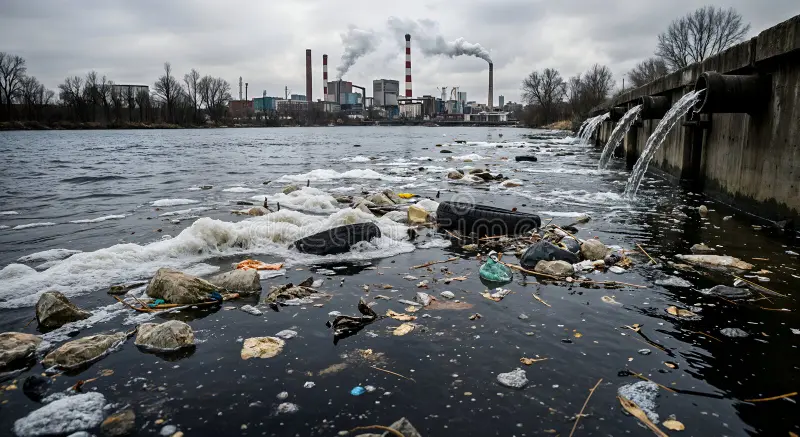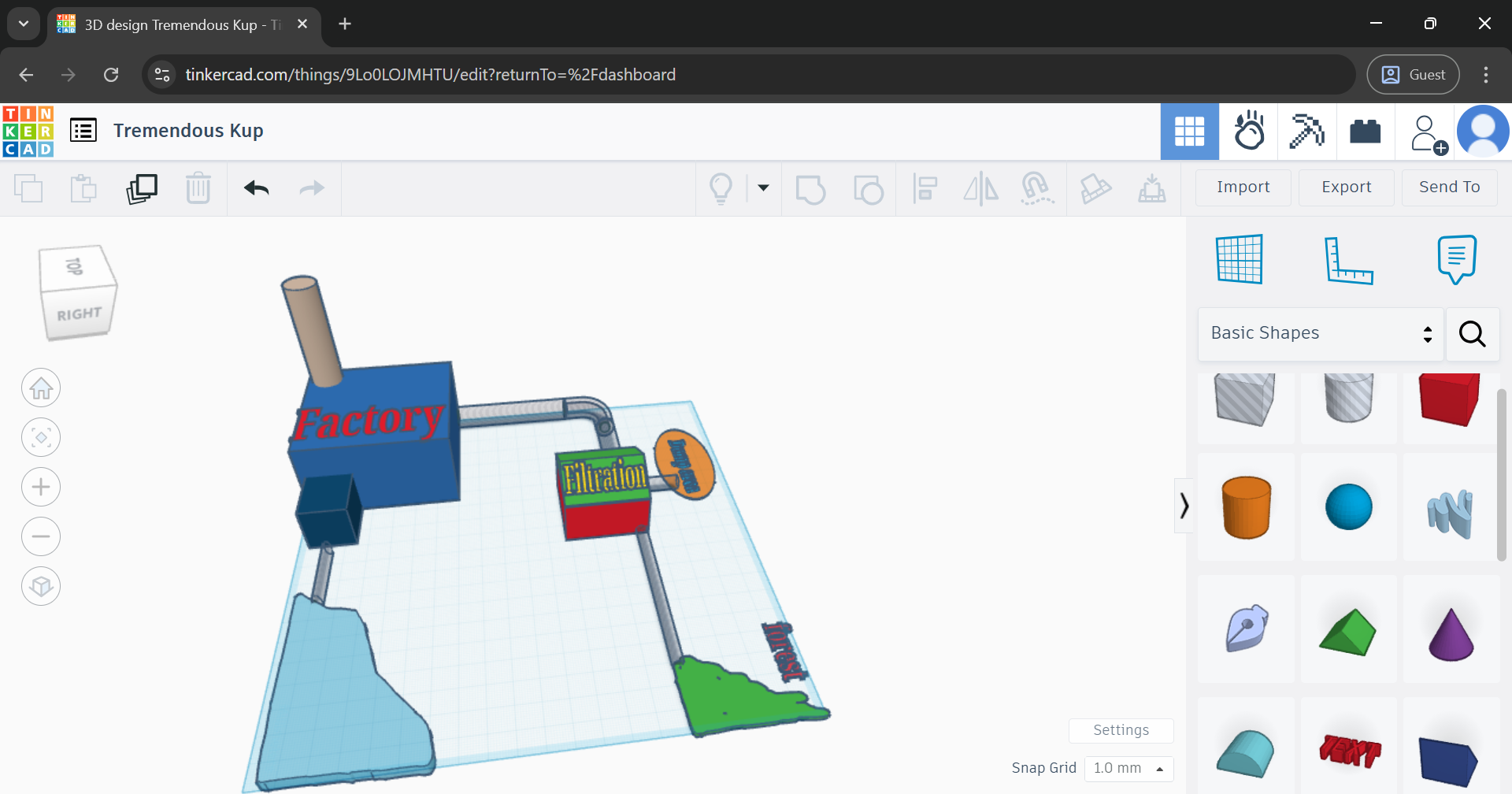The people who use the water from the river having the problem of dirty water which are released by the factories.
By setting up a filtering system. Which purify the water.
Sarlanagar, Maihar ,MP, INDIA
Solution
| Component | Description |
|---|---|
| Technical Components | ### 1. Technical Components Needed #### Solid Filtration - **Touch Sensor**: To detect and separate solid waste from water. This could be a mechanical filter with sensors to detect blockages or changes in flow rate. - **Conveyor Belt**: To transport separated solid waste to a collection point. - **Mechanical Filters**: Screens or meshes of varying sizes to capture solid particles. #### Chemical Filtration - **Touch Sensor**: To monitor the filtration process and detect any anomalies. - **Moisture Sensor**: To measure the water content and ensure proper chemical separation. - **Chemical Filters**: Activated carbon filters, ion exchange resins, or other chemical treatment systems to remove contaminants. #### Final Filtration - **Sensor**: A combination of pH sensors, turbidity sensors, and conductivity sensors to ensure water purity. - **UV Sterilization**: To kill any remaining microorganisms. - **Reverse Osmosis**: To remove any remaining dissolved solids. #### Robots - **Touch Sensor**: For detecting and handling waste. - **Motion Sensor**: To navigate and avoid obstacles. - **Camera**: For visual inspection and navigation. - **Robotic Arms**: To clean and maintain filtration machines. - **Autonomous Vehicles**: To transport waste to disposal sites. #### Safety and Security - **Camera**: For surveillance of the plant. - **Buzzer and Alarm**: To alert in case of emergencies or security breaches. - **Fire Suppression System**: To handle any chemical fires. - **Gas Detectors**: To detect harmful gases. ### 2. Recommended Tech Stack #### Hardware - **Sensors**: pH, turbidity, conductivity, touch, moisture, motion, and gas sensors. - **Microcontrollers/PLCs**: Arduino, Raspberry Pi, or industrial PLCs for control systems. - **Actuators**: Pumps, valves, and motors for controlling the flow of water and waste. - **Robotics**: Custom-built robots with arms and autonomous navigation capabilities. - **Networking**: Ethernet or Wi-Fi for communication between devices and central control. #### Software - **Control Software**: Custom software for monitoring and controlling the filtration process (Python, C++, or PLC programming languages). - **Machine Learning**: For predictive maintenance and anomaly detection (Python with TensorFlow or PyTorch). - **Database**: To log sensor data and system status (SQL or NoSQL databases). - **User Interface**: Web-based dashboard for monitoring and control (HTML, CSS, JavaScript). ### 3. Detailed Implementation Steps 1. **Solid Filtration**: - Install mechanical filters (screens) of varying sizes to capture solid waste. - Use touch sensors to monitor filter blockages and trigger maintenance. - Conveyor belts transport solid waste to a collection point. 2. **Chemical Filtration**: - Pass water through activated carbon filters to remove organic chemicals. - Use ion exchange resins to remove heavy metals and other ions. - Monitor the process with touch and moisture sensors to ensure efficiency. 3. **Final Filtration**: - Use reverse osmosis to remove any remaining dissolved solids. - Sterilize water with UV light to kill microorganisms. - Test water purity with pH, turbidity, and conductivity sensors before release. 4. **Robots for Maintenance**: - Deploy robots with cameras and motion sensors to navigate the plant. - Use robotic arms to clean filters and other equipment. - Autonomous vehicles transport waste to disposal sites. 5. **Safety and Security**: - Install cameras for surveillance. - Use buzzers and alarms to alert staff of emergencies. - Implement gas detectors and fire suppression systems for safety. 6. **Supervision**: - Human operators monitor the system via a central dashboard. - Regular maintenance and calibration of sensors and equipment. ### 4. Required Technical Learning - **Sensor Integration**: Learn how to interface various sensors with microcontrollers or PLCs. - **Robotics**: Understand the basics of robotics, including navigation and manipulation. - **Control Systems**: Learn about feedback loops and control algorithms. - **Water Treatment**: Study the principles of water filtration and chemical treatment. - **Software Development**: Gain skills in programming languages like Python, C++, and PLC languages. - **Machine Learning**: Learn how to apply ML for predictive maintenance and anomaly detection. ### 5. Budget Calculation #### Hardware Costs 1. **Sensors**: - pH sensor: $50 x 5 = $250 - Turbidity sensor: $100 x 5 = $500 - Conductivity sensor: $80 x 5 = $400 - Touch sensor: $20 x 10 = $200 - Moisture sensor: $30 x 5 = $150 - Motion sensor: $40 x 5 = $200 - Gas detector: $150 x 5 = $750 - Camera: $100 x 10 = $1,000 - Buzzer and alarm: $50 x 5 = $250 - **Total**: $3,700 2. **Filtration Equipment**: - Mechanical filters: $1,000 x 2 = $2,000 - Activated carbon filters: $2,000 x 2 = $4,000 - Ion exchange resins: $3,000 x 2 = $6,000 - Reverse osmosis system: $5,000 x 1 = $5,000 - UV sterilization: $1,000 x 1 = $1,000 - **Total**: $18,000 3. **Robotics**: - Robotic arms: $5,000 x 2 = $10,000 - Autonomous vehicles: $10,000 x 2 = $20,000 - **Total**: $30,000 4. **Control Systems**: - Microcontrollers/PLCs: $500 x 5 = $2,500 - Networking equipment: $1,000 - **Total**: $3,500 5. **Miscellaneous**: - Conveyor belts: $2,000 - Pumps and valves: $3,000 - Fire suppression system: $5,000 - **Total**: $10,000 **Total Hardware Costs**: $65,200 #### Software Costs 1. **Licenses**: - PLC software: $1,000 - Database license: $500 - **Total**: $1,500 2. **APIs and Subscriptions**: - Cloud services (data logging): $500/year - **Total**: $500 **Total Software Costs**: $2,000 #### Maintenance Costs (First Year) 1. **Hardware Maintenance**: 10% of hardware costs = $6,520 2. **Software Maintenance**: 20% of software costs = $400 3. **Labor**: $50,000/year (for technicians and operators) **Total Maintenance Costs (First Year)**: $56,920 #### Total Estimated Budget - **Hardware**: $65,200 - **Software**: $2,000 - **Maintenance (First Year)**: $56,920 - **Grand Total**: $124,120 ### Notes: - The budget is an estimate and can vary based on specific requirements and vendor pricing. - Labor costs are based on an assumption of one full-time technician and part-time operators. - Additional costs for installation, training, and contingency should be considered. |
| Key Features |
Feature: Solid filtration
Format: Touch sensor Usage: it separate solid waste from water
Feature: Chemical filtration
Format: Touch sensor and Moisture sensor Usage: it separate chemical waste from waste
Feature: Final filtration
Format: Sensor Usage: it ensure that water is pure or not
Feature: Robots
Format: Touch sensor, Motion sensor, Camera Usage: it clean filtration machines
Feature: Safety and Security
Format: Camera , Buzzer and Alarm Usage: it ensure safety of plant |
| Implementation Steps | We are making a filtration plant that filters the acidified water which is released from the factory. So it can use by the peoples living near water bodies. - First, it separate the solid waste from water. -Second, it separate the chemical waste from water. -Third, it ensure the water is fully pure and clean or not. -Fourth, after water release and then robots go and take the waste remain in filtrations machine. -Fifth, then it give to robot truck and they dump the waste. -Finally, this all process is supervise by humans. |

